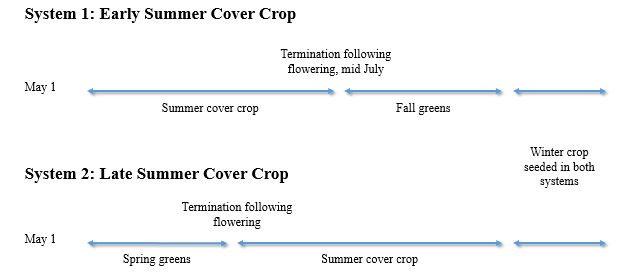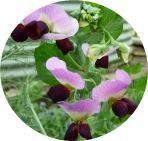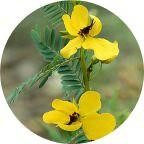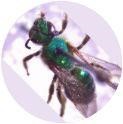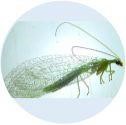eOrganic authors:
Naomy Candelaria, University of Minnesota St. Paul
Julie Grossman, University of Minnesota St. Paul
Anne Pfeiffer, University of Wisconsin Madison
Adria Fernandez, University of Minnesota St. Paul
Mary Rogers, University of Minnesota St. Paul
Summer Cover Crops in Organic Systems
Summer cover crops can be a pragmatic way of increasing diversity in organic systems where ecosystem services are crucial for overall system functionality. Ecosystem services are defined as aspects of the environment that are used for the inherent benefit of human welfare (Boyd and Banzhaf, 2007). Summer cover crops are an underexplored rotation option for organic farming systems due to a limited growing season, but may provide a wide range of ecosystem services such as contributing to soil nutrients and beneficial insect populations. This article presents practical information for those wishing to explore the use of summer cover crops in their organic farming operations.
Though cover crops can provide an array of ecosystem services, growers must choose which specific benefits to prioritize. It is crucial to identify the reasons for integrating a cover crop and make management decisions accordingly—whether to provide N for the subsequent crop, diminish weed growth, protect the soil from erosion, add floral resources, or some other goal. Key ecosystem services addressed in this article include soil nitrogen management and habitat provision for beneficial insects.
Soil Nutrient Contribution
For organic farmers, careful nutrient management decisions are critical due to synthetic fertilizer restrictions, increasing emphasis on providing nutrients via biological inputs. In particular, choosing summer cover crop species can impact soil nutrient availability. For example, grass species have extensive root systems that can mine deep into the soil profile, bringing more available nutrients into the top layer where most crop roots are clustered. Legume species can provide fixed N from the atmosphere and leave a bank of available nutrients for subsequent cash crops. These functional traits warrant serious consideration for farmers when deciding which summer cover crops to use in their rotations.
Summer cover crops can provide nutrient management benefits through nitrogen-fixation (legumes) and nitrogen scavenging capacity (grasses). Legume cover crops have the capacity to supply fixed nitrogen from the atmosphere via a symbiosis with soil bacteria, providing a free source of N to organic crops. However, when the soil is relatively high in nitrogen, legumes commonly reduce the degree to which they carry out nitrogen fixation. This is primarily attributed to high resource expenses needed to achieve N fixation, and the reliance on the available soil N (Kiers et al., 2003). However, growers can encourage legumes to fix a higher rate of atmospheric N by incorporating grasses in a mix. Grasses, known to be efficient nitrogen scavengers, can take up soil N surplus and decrease excessive available soil nutrient pools for legume species. Moreover, planting grasses alone can be useful in systems with excess N in the soil by preventing nutrient loss from the system.
Beneficial Insects
In light of these ecosystem services, summer cover crops play an important role in certified organic systems. Using results from a one-year field study in Minnesota, we present data on biomass and nitrogen contributions from 16 species of cover crops and cover crop mixes, as well as beneficial insect populations associated with each treatment combination.

Figure 1. Summer cover crops at the University of Minnesota St. Paul. Photo credit: Naomy Candelaria.
Summer Cover Crop Establishment and Management
Maximization of ecosystem services relies on thoughtful cover crop management. The total amount of nitrogen contributed from both legume and grass cover crops depends on the amount of biomass produced. Cover crops with the capacity to produce greater amounts of biomass will subsequently provide more N to organic systems. Similarly, vigorous growth and flowering provide the desired forage and habitat for beneficial insects. Therefore, emphasis on management should include planting time and establishment, species selection, planting density, weed control capacity, and termination strategies.
Planting time: Summer cover crops can be added to existing rotations established spatially—alongside cash crops that are in production, or in field edges and fallow areas of the farm; or temporally—before or after cash crop production. Cover crops are often planted after the main crop has been harvested, primarily because there is no competition between the cover crop and the main crop. However, an increasing number of growers are finding timing niches during the summer season when cover crops may be included. Opportunities may include a mid-summer cover integrated between an early spring crop and a late summer or fall cash crop, or an early summer cover crop succession before a late summer/fall cash crop.
Figure 2: Figure credit:Julie Grossman
Species mix: Cover crop benefits can be achieved when planted in single-species stands or as mixes. Benefits are often maximized by planting legume-grass mixes where the grass can act as a nurse crop for a slower growing legume, and push the system to fix an overall higher level of atmospheric nitrogen (Creamer and Baldwin, 2000). Mixes typically include a variety of grasses, legumes, and Brassicas. Expanding the typical list of commonly used cover crops to include flowering species attractive to beneficial insects may increase the provision of desired ecosystem services. Choosing species that are adapted to the growing conditions during the planting window selected will improve overall system performance. Cool-season crops should be limited to spring and fall, while heat-loving species should be selected for midsummer planting. Several excellent resources provide detailed information about specific species, including ecosystem benefits, and time to maturity can be useful in building a system that is suited to the unique goals and growing conditions of an individual farm (see resource list).
Planting and establishment: Depending on the scale and available infrastructure of a farm, cover crops can be broadcast, drilled, or for particularly large plots, aerially seeded. Typically, seeding rates are increased when broadcast to account for a less reliable seed-to-soil contact. A light raking or very light, shallow tilling after broadcast seeding is often used to bury seed slightly.
Growers trying to maximize their growing season can interseed cover crops into a standing cash crop after the critical growth period of the cash crop. However, if covers are planted too early or not managed properly, interseeded cover crops can also impede the growth of the main crop by competing for resources such as sunlight, water, nutrients, and space. Species with relatively shorter stature than the cash crop and limited lateral growth will typically be the best choices to minimize resource competition. It is also critical to avoid providing habitat for cash crop pests, such as Lygus lineolaris (tarnished plant bug) and other related species. Cover crop species that exhibit allelopathic characteristics, such as Secale cereale (winter rye) or Sorghum × drummondii (sorghum sudangrass), are not recommended for interplanting.
When growing summer cover crops, special attention should be given to germination and irrigation. While spring and fall cover crops can often rely on natural rainfall to provide adequate water for establishment, the summer months' warmer, drier climate may require supplemental irrigation. The soil surface must be kept moist until the crop germinates, with special care given to prevent surface crusting that could prevent emergence.
Termination: Plans for cover crop termination should be made prior to planting to ensure that the chosen species are well suited to the farm system. Appropriate equipment must be available at the necessary time to terminate crops and manage residue. Tall or fibrous cover crops require a higher level of mechanized equipment than lower growing or more delicate species. Typically, cover crops are mowed and then incorporated into the soil as soon as practicable. Allowing the residue to dry on the surface for one to two days can make the incorporation of large amounts of residue more manageable. However, nitrogen is quickly lost from decomposing cover crop residue and should be incorporated as quickly as possible to capture the N in the soil. Allowing the cover crop to break down in the soil for ten days to two weeks prior to planting the next cash crop allows time for microbial decomposition of the cover crop and improved nutrient availability for the incoming crop (Magdoff and Van Es, 2010).
Termination considerations are especially important with summer cover crops, as warm summer temperatures may result in larger quantities of biomass production as well as faster decomposition than is typical in spring or fall. Growers should be prepared to manage a large mass of crop residue, and also be aware that it may be possible to shorten the interval between cover crop termination and cash crop planting during the summer niche.

Figure 3. Termination of cover crops using a BCS mower. Photo credit: Pippa Dobbyn.
This research was conducted in summer 2019 (May-September) at the Minnesota Agricultural Experiment Station fields located at University of Minnesota, St. Paul. Species were recommended by the Xerces Society based on their capacity to attract pollinators. Choices included treatment mixes of monocultures and polycultures, with a total of 16 species evaluated. Initial trade-offs between N provision and beneficial insect services associated with flowering cover crops were explored.
Table 1. Primary ecosystem services of cover crop species
| Cover Crop Species | Primary ecosystem service | Image |
| Phacelia (Phacelia tanacetifolia) | Pollinator resource |
|
| Sunn hemp (Crotalaria juncea L.) | Soil conservation and nutrient provision |
|
| Field pea (Pisum sativum subsp. arvense) | Pollinator habitat/soil conservation and nutrient provision |
|
| Partridge pea (Chamaecrista fasciculata) | Pollinator resource/soil conservation and nutrient provision |
|
| Crimson clover (Trifolium incarnatum) | Pollinator habitat/soil conservation and nutrient provision |
|
| Peredovik Sunflower (Helianthus annuus) | Organic matter addition and pollinator resource |
|
| Buckwheat (Fagopyrum esculentum) | Soil conservation and nutrient provision |
|
| Oats (Avena sativa) | N scavenger, biomass provision and soil conservation |
|
Summer Cover Crop Biomass and Nutrient Contributions
Our study at the University of Minnesota demonstrated that a mix of summer cover crops containing field peas, clovers, and oats contributed the highest amount of N (237 pounds of N per acre) relative to other species combinations. Further studies using field peas in monoculture have reported up to 161 pounds of N per acre (Beckie et al., 1997). Biomass contribution by summer cover crops and cover crop mixes was primarily supplied by the mix containing field peas, clovers, and oats (7,804 pounds per acre), followed by phacelia (4,492 pounds per acre) and sunflower (3,792 pounds per acre) monocultures.
Summer Cover Crop for Beneficial Insect Ecosystem Services
Of the species that flowered, buckwheat demonstrated the fastest time to flowering after planting at 42 days, followed by field peas and phacelia (56 days). Sunflower time to flowering was the longest of all evaluated species, at 76 days. Flower duration was maximized by phacelia with 27 days of the total flowering period, followed by field peas (20 days), buckwheat (13 days), and sunflower (7 days). Insect data collected showed the presence of families such as Apidae (bees), Coccinellidae (lady beetles), Syrphidae (pollinator-predator syrphid flies), Pteromalidae (parasitoids), Miridae (plant bugs), and Thripidae (herbivores). Herbivore pressure by thrips was predominant in a treatment containing legumes (clovers and peas) and grasses (oats). A mixture containing legumes (peas), grasses (oats and millet), brassicas (canola and radish), and buckwheat had the highest presence of syrphid flies, while the phacelia monoculture attracted most bees.
Table 2. Beneficial insects attracted by cover crops
| Picture | Name | Benefit |
|
| Family: Pteromalidae Parasitoid wasps | Parasitoid wasp, many different species. Provide biological control for various insect pests. |
|
| Family: Apidae Bumblebees and honey bees | Includes many species of native bumblebees and non-native honey bee pollinators |
|
| Family: Halictidae Sweat bees | Most species are pollen feeders, usually dark-colored and often metallic in appearance. Some species are important pollinators. |
|
| Family: Syrphidae Hoverflies or flower flies | Some species are predators in the larval stage and provide biological control of pests, others are important pollinators |
|
| Family: Coccinellidae Lady beetles | Native species are important generalist predators of insect pests |
|
| Family: Chrysopidae Lacewings | Larvae are generalist predators of insect pests |
Key Takeaways
- Phacelia, sunflower, buckwheat, and field peas provided beneficial insect habitat and also contributed abundant biomass at termination, which is important to improve soil organic matter and long-term soil health maintenance in organic systems.
- A mix of field peas, clovers, and oats contributed the highest pounds of nitrogen per acre.
- Adding summer cover crops can be an excellent tool for organic farmers to support soil health, add nutrients, and attract beneficial insects to sustain main crops.
Summary
Intensive vegetable crop rotations can have detrimental effects on soil health, draining soil of organic matter reserves and necessitating nitrogen inputs. Many vegetable crop rotations also leave little time or space to integrate beneficial insect and pollinator habitat into crop rotations. The lack of habitat causes declines, leading to insufficient pollination services and increased pest incidence. In Minnesota, a short summer fallow period in organic vegetable crop rotations presents a valuable opportunity to introduce cover crop mixes during this window when soils are often bare. As these flowering cover crop mixtures are introduced into farmers' rotations, pollinator presence may also be increased. Little knowledge exists regarding the extent to which summer cover crop options contribute to soil nutrients and beneficial insect habitat in organic farming systems. A trade-off may exist between ecosystem services, including beneficial insect habitat provision and nutrient contribution. This project explores the effect of flowering cover crop mixes on N provision and presence of forage for beneficial insects. Nine treatments containing one to seven species of cover crops were evaluated for flowering time, N content, soil N contribution, and pollinator attraction. The species Phacelia tanacetifolia in monoculture added the most biomass, followed by sunflower monoculture. Buckwheat (Fagopyrum esculentum) demonstrated the shortest time to flower.
Beneficial insect presence ranged from pollinators (native, honey, and bumblebees) to predators (syrphid flies and green lacewings) and parasitoids. A treatment composed of one legume, two kinds of grass, two Brassicas, and buckwheat showed the highest presence of flies in the Syrphidae family and Phacelia monoculture was the most attractive for bees (Apidae), which may both provide pollination services.
Additional Resources
- Cover cropping for pollinators and beneficial insects [Online]. 2015. Sustainable Agriculture Research and Education. Available at: https://www.sare.org/resources/cover-cropping-for-pollinators-and-beneficial-insects/. (verified 10 Dec 2020).
- Habitat planning for beneficial insects [Online]. 2016. Xerces Society. Available at: https://xerces.org/publications/guidelines/habitat-planning-for-beneficial-insects (verified 10 Dec 2020).
- Managing cover crops profitably, 3rd edition [Online]. Sustainable Agriculture Research and Education. Available at: https://www.sare.org/resources/managing-cover-crops-profitably-3rd-edition/ (verified 10 Dec 2020).
- Midwest cover crops field guide, second edition. 2014. Midwest Cover Crops Council. Available for purchase at: https://ag.purdue.edu/agry/dtc/Pages/CCFG.aspx (verified 10 Dec 2020).
- Upper Midwest citizen scientist pollinator monitoring guide: Native bees [Online]. 2016. Xerces Society. Available at: https://xerces.org/publications/id-monitoring/upper-midwest-citizen-scientist-pollinator-monitoring-guide-native (verified 10 Dec 2020).
References and Citations
- Ashman, T. L., T. M. Knight, J. A. Steets, P. Amarasekare, M. Burd, D. R. Campbell, M. R. Dudash, M. O. Johnston, S. J. Mazer, R. J. Mitchell, M. T. Morgan, and W. G. Wilson. 2004. Pollen limitation of plant reproduction: Ecological and evolutionary causes and consequences. Ecology 85:2408—2421. (Available online at: https://esajournals.onlinelibrary.wiley.com/doi/10.1890/03-8024) (verified 6 Nov 2020).
- Beckie, H. J., and S. A Brandt. 1997. Nitrogen contribution of field pea in annual cropping systems. 1. Nitrogen residual effect. Canadian Journal of Plant Science 77:311—322. (Available online at: https://cdnsciencepub.com/doi/abs/10.4141/P96-161) (verified 6 Nov 2020).
- Boyd, J., and S. Banzhaf. 2007. What are ecosystem services? The need for standardized environmental accounting units. Ecological Economics 63:616—626. (Available online at: https://doi.org/10.1016/j.ecolecon.2007.01.002) (verified 6 Nov 2020).
- Creamer, N. G., and K. R. Baldwin. 2000. An evaluation of summer cover crops for use in vegetable production systems in North Carolina. HortScience 35:600—603. (Available online at: https://journals.ashs.org/hortsci/view/journals/hortsci/35/4/article-p600.xml) (verified 6 Nov 2020).
- Daily. G. C. (ed.) 1997. Nature's services: Societal dependence on natural ecosystems. Island Press, Washington, DC. (Available online at: https://books.google.com/books?hl=en&lr=&id=Mwy8BwAAQBAJ&oi=fnd&pg=PR2&dq=Daily.+G.+C.,+editor.+1997.+Nature%E2%80%99s+Services:+Societal+Dependence+on+Natural+Ecosystems.&ots=00499ARGyI&sig=3-kDW4WdQxB4CpIJPQ83_aTgmrQ#v=onepage&q&f=false) (verified 6 Nov 2020).
- Finney, D. M., and J. P. Kaye. 2017. Functional diversity in cover crop polycultures increases multifunctionality of an agricultural system. Journal of Applied Ecology 54:509—517. (Available online at: https://besjournals.onlinelibrary.wiley.com/doi/full/10.1111/1365-2664.12765) (verified 6 Nov 2020).
- Florentín, M. A., M. Peñalva, A. Calegari, and R. Derpsch. 2010. Green manure/cover crops and crop rotation in conservation agriculture on small farms. Integrated Crop Management. FAO 12. (Available online at: http://www.fao.org/fileadmin/user_upload/agp/icm12.pdf) (verified 6 Nov 2020).
- Gallai, N., Salles, J., J. Settele, and B. Vaissiere. 2009. Economic valuation of the vulnerability of world agriculture confronted with pollinator decline. Ecological Economics 68: 810—821. (Available online at: https://www.sciencedirect.com/science/article/abs/pii/S0921800908002942) (verified 6 Nov 2020).
- Giller, K. E., and G. Cadisch. 1995. Future benefits from biological nitrogen fixation—An ecological approach to agriculture. Plant Soil 174:255—277. (Available online at: https://link.springer.com/article/10.1007/BF00032251) (verified 6 Nov 2020).
- Kearns, C. A., D. W. Inouye, N. M. Waser. 1998. Endangered mutualisms: The conservation of plant–pollinator interactions. Annual Review of Ecology and Systematics 29:83—112. (Available online at: https://www.annualreviews.org/doi/abs/10.1146/annurev.ecolsys.29.1.83) (verified 6 Nov 2020).
- Kiers, E. T., R. A. Rousseau, S. A. West, and R. F. Denison. 2003. Host sanctions and the legume–rhizobium mutualism. Nature 425:78—81. (Available online at: https://pubmed.ncbi.nlm.nih.gov/12955144/) (verified 6 Nov 2020).
- Landis, D. A., F. D. Menalled, A. C. Costamagna, and T. K. Wilkinson. 2005. Manipulating plant resources to enhance beneficial arthropods in agricultural landscapes. Weed Science 53(6):902—908. (Available online at: https://www.cambridge.org/core/journals/weed-science/article/manipulating-plant-resources-to-enhance-beneficial-arthropods-in-agricultural-landscapes/B3DDDAFB42C801C93BD7B29C9E154060) (verified 6 Nov 2020).
- Magdoff, F., and H. Van Es. 2009. Building soils for better crops: Sustainable soil management. Sustainable Agriculture Research and Education (SARE). (Available online at: https://www.sare.org/wp-content/uploads/Building-Soils-For-Better-Crops.pdf) (verified 6 Nov 2020).
- McGregor, S. E. 1976. Insect pollination of cultivated crop plants. Agricultural Research Service, USDA Agriculture Handbook 496. Continuously updated online version available at: https://www.ars.usda.gov/ARSUserFiles/20220500/onlinepollinationhandbook.pdf (verified 10 Dec 2020).
- Nicholls, C. I., and M. A. Altieri. 2013. Plant biodiversity enhances bees and other insect pollinators in agroecosystems. A review. Agronomy for Sustainable Development: 257—274. (Available online at: https://food.berkeley.edu/wp-content/uploads/2020/07/2012_Nicholls-and-Altieri_Plant-biodiversity-enhances-bees-and-other-insect-pollinators-in-agroecosystems.-A-review.pdf) (verified 6 Nov 2020).
- Sarrantonio, M. 1989. Selecting the best cover crops for your farm. In: Managing Cover Crops Profitably. SARE:12—15. (Available online at: https://www.sare.org/publications/managing-cover-crops-profitably/selecting-the-best/) (verified 10 Dec 2020).
- Wäckers, F. L., J. Romeis, P. van Rijn. 2007. Nectar and pollen feeding by insect herbivores and implications for multitrophic interactions. Annual Review of Entomology 52: 301—323. (Available online at: https://pubmed.ncbi.nlm.nih.gov/16972766/) (verified 6 Nov 2020).
- Wade, T., R. Claassen, and S. Wallander. 2015. Conservation practice adoption rates vary widely by crop and region. U.S. Department of Agriculture, Economic Research Service, EIB 147. (Available online at: https://www.ers.usda.gov/webdocs/publications/44027/56332_eib147.pdf?v=0) (verified 6 Nov 2020).
- Wratten, S. D., M. Gillespie, A. Decourtye, E. Mader, and N. Desneux. 2012. Pollinator habitat enhancement:Benefits to other ecosystem services. Agriculture, Ecosystems and Environment 159:112—122. (Available online at: https://www.academia.edu/23818285/Pollinator_habitat_enhancement_Benefits_to_other_ecosystem_services) (verified 6 Nov 2020).
